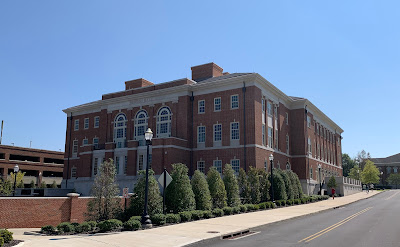We moved on to Alabama and stopped for a few days so we could visit the University of Alabama in Tuscaloosa.
We drove through the university and loved the beautiful buildings.
As usual, we had a difficult time finding a place to park but finally found a spot slightly off campus so off we went on foot. Ron has great recall of historical events and remembered this was the campus where the "Stand in the Schoolhouse Door" took place in 1963 at the Foster Auditorium at the University. So I pulled out maps on my phone and we made our way there.
The Stand in the Schoolhouse Door took place on June 11, 1963. George Wallace, the Governor of Alabama, in an attempt to keep his inaugural promise of "segregation now, segregation tomorrow, segregation forever" and stop the desegregation of schools stood at the door of the auditorium as if to block the entry of two African American students: Vivian Malone and James Hood.
In response, President John Kennedy issued an Executive Order, which federalized the Alabama National Guard, and Guard General Henry V. Graham commanded Wallace to step aside. Wallace spoke further, but eventually moved, and Malone and Hood completed their registration. The incident brought Wallace into the national spotlight.
And here we were at the historic Foster Auditorium.
Foster Auditorium, 1939
Named for Richard Clarke Foster (1895-1941)
President of the University of Alabama (1937-1941)
Photo courtesy of Wikipedia
Forrest Gump fans may remember the scene where Forrest was standing in the crowd during the event. Forrest watched on as George Wallace made his speech against admitting the students into white schools. While two black students entered the university, Forrest noticed that one of them dropped a book and he ran to give it back to her.
Photo courtesy of youtube.com
Across the walkway is the Lucy Clock Tower.
Autherine Lucy (1929-2022) was the first African-American student to attend the University of Alabama in 1956. Her expulsion from the university later that year led to the university president's resignation. Years later, she was admitted as a master's student and in 2010 the clock tower was erected in her honor.
The Denny Chimes is nearby.
We continued through campus and came across this.
Just a few steps from the sorority is the football stadium.
When the stadium opened in 1929, it was named the Denny Stadium in honor of George H. Denny, the school's president from 1912 to 1932. In 1975, the state legislature added longtime head coach and alumnus Paul "Bear" Brant to the stadium's name. Bryant led the Tide for seven more seasons, through 1982, and is one of the few coaches in Division 1 football to have coached in a venue bearing his name. With a seating capacity of 100,077, it is the fourth-largest stadium in the Southeastern Conference, the eighth-largest stadium in the country, and the tenth-largest stadium in the world.
Leading up to the stadium is the Walk of Champions.
Next to the stadium is Tuska. The official mascot of the University is an elephant and is sometimes known as Big Al, but this sculpture is known as Tuska.
Back to the truck for another point of interest but before that, we had to stop for some Bama Stuff.
Yes, he bought one
On to Birmingham to finish the tour, we stopped at Elmwood Cemetery to see the final resting place of the famous coach, Paul "Bear" Bryant, considered by many to be one of the greatest college football coaches of all time.
Paul William Bryant, Sr.
Sept. 11, 1913 - Jan. 26, 1983
During his 25-year tenure as Alabama's head coach, Bryant amassed six national championships and thirteen conference championships. Upon his retirement in 1982, he held the record for the most wins (323) as a head coach in collegiate football history. He was known for his trademark black and white houndstooth hat.
Photo courtesy of Ron Moody, findagrave.com
I'm so glad we were able to make this stop. We had more to see in Alabama - stay tuned.























No comments:
Post a Comment